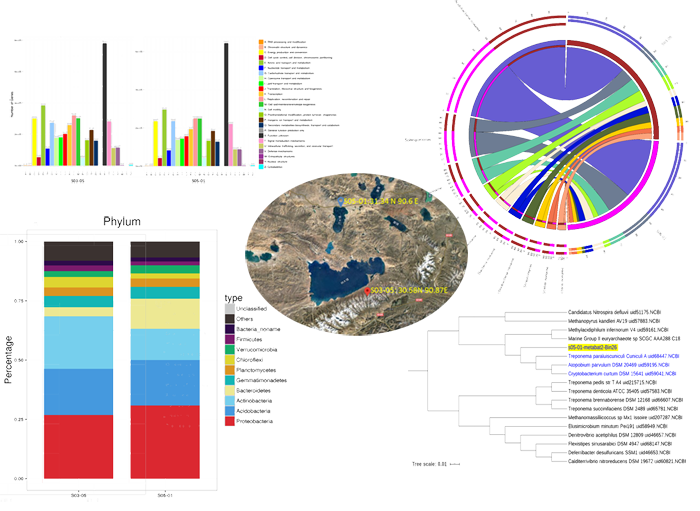Our mission
We use computing to decode life.
Recent progress of our group |
================== Research information ================== |
Dai Chaoxu discussed the species composition and ecological function of soil microorganisms in Namco and Bamuco lakes in Tibet.
|
|
Abstract: Microorganisms are huge groups closely related to the development of human society and the ecological environment, and play an important role in regulating the environment. Soil is an important place for microorganisms to live, and it is a natural medium for the growth and reproduction of microorganisms. Soil microorganisms are the general term for all tiny organisms in the soil that cannot be observed by the naked eye. With the increase of human activities and the increase of global temperature, the global climate change caused by the increase in temperature has a profound impact on human life and the natural environment. The unique geographical environment of Qinghai-Tibet Plateau has a very important impact on the climate of China and the world. Alpine grasslands, alpine meadows and swampy meadows in the Namco Lake and Bamuco Lake areas of the Qinghai-Tibet Plateau are staggered distributed, which is an ideal place to study climate and environmental changes.
In this syudy, the soil near Namco Lake and Bamuco Lake was collected, and metagenomic sequencing analysis was conducted to study the soil microbial species community composition and ecological function. The main experimental results are as follows:
(1) In terms of the microbial community composition of the two soil metagenomics, s03-05 and s05-01, bacteria took an absolute advantage (98.12% and 98.38%, respectively), and the contents of archaea, fungi, eukaryotes, and viruses were very small.
(2) In abundance of the Phylum level, Proteobacteria (26.82%) in s03-05 had the highest abundance, followed by Actinobacteria (22.16%), Acidobacteria (19.45%) and Bacteroidetes (3.81%); The abundance of s05-01 was Proteobacteria (30.86%), Acidobacteria (19.13%), Actinobacteria (13.16%), Bacteroidetes (12.72%), and Gemmatimonadetes (4.96%).
(3) Both the proteobacteria of s03-05 and s05-01 contain the α- proteobacteria, the β-proteobacteria, the γ -proteobacteria, and the δ- proteobacteria. Most of the bacteria of the α- proteobacteria can be found in deep ocean sediments, glaciers or deep soil, suggesting that both samples contain low concentrations of nutrients, which is consistent with the extreme alpine environment of the Tibetan plateau. The β-proteobacteria has a variety of metabolic modes, including chemoautotrophs, photoautotrophs and heterotrophs bacteria. Most of the subsurface soil belongs to chemoautotrophs. The bacterial composition of the two samples revealed that the utilization of carbon source in the soil of Qinghai-Tibet Plateau through bacterial metabolism, which plays a significant role in carbon conservation.
(4) COG annotation results of s03-05 and s05-01 are as follows: in the two samples, amino acid transport and metabolic functions are the main ones, which are 8.68% and 8.20% respectively. However, the abundance of normal function prediction, RNA processing and modification, chromatin structure and dynamics, extracellular structure, nuclear structure and cytoskeleton were very low in the two soil metagenomics.
(5) KEGG annotation results showed that: in the level 1 pathway of s03-05 and s05-01, the metabolic pathway with the highest abundance from functional gene annotation, and the abundance was 60.47% and 61.12%, respectively. In the secondary pathway, the carbohydrate metabolism pathway had the highest abundance (15.02% and 15.51%, respectively).The results of CAZy annotation showed that the enzymes with the highest abundance in the two samples were glycosyltransferase and glycoside hydrolase, followed by glycoside hydrolase. It can be seen that in the two soil samples, energy metabolism is relatively vigorous, which is involved in the metabolism and circulation of carbon. It is revealed that soil microorganism is an important component of carbon and nitrogen cycling in Qinghai-Tibet Plateau.
(6) High-quality Bin analysis results of s05-01: GO annotation results showed that in Bin11, Bin13 and Bin26, the abundance of the biological processes, the molecular functions, and the cell components performed by genes are located were basically similar. The results of COG annotation showed that the content of carbohydrate transport and metabolism in Bin11 was the highest with 12.49% (212), and that of cell wall/membrane/envelope bioregenesis and amino acid transport and metabolism in Bin13 and Bin26 were the highest with 7.13% (238) and 7.76%(259), respectively. Phylogenetic analysis of Bin26 showed that the closest evolutionary species were those belonging to the levels of actinomycetes and spirochetes. The results of RAST annotation on Bin26 showed that the genes and enzymes were mainly related to carbohydrate, nitrogen and sulfur metabolism.
The results of this study provide important basic data for understanding the interaction between soil microorganism and global climate change in Qinghai-Tibet Plateau.

We use computing to decode life.